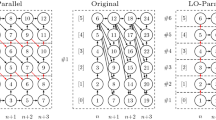Abstract
Numerical methods for ordinary initial value problems that do not depend on special properties of the system are usually found in the class of linear multistage multivalue methods, first formulated by J.C. Butcher. Among these the explicit methods are easiest to implement. For these reasons there has been considerable research activity devoted to generating methods of this class which utilize independent function evaluations that can be performed in parallel. Each such group of concurrent function evaluations can be regarded as a stage of the method. However, it turns out that parallelism affords only limited opportunity for reducing the computing time with such methods. This is most evident for the simple linear homogeneous constant-coefficient test problem, whose solution is essentially a matter of approximating the exponential by an algebraic function. For a given number of stages and a given number of saved values, parallelism offers a somewhat enlarged set of algebraic functions from which to choose. However, there is absolutely no benefit in having the degree of parallelism (number of processors) exceed the number of saved values of the method. Thus, in particular, parallel one-step methods offer no speedup over serial one-step methods for the standard linear test problem. Although the implication of this result for general nonlinear problems is unclear, there are indications that dramatic speedups are not possible in general. Also given are some results relevant to the construction of methods.
Similar content being viewed by others
References
A. Bellen, Parallelism across the steps for difference and differential equations, in:Numerical Methods for Ordinary Differential Equations, eds. A. Bellen, C.W. Gear and E. Russo, Proceedings, L'Aquila, 1987, Lecture Notes in Mathematics no. 1386 (Springer, Berlin, 1989) pp. 22–35.
L.G. Birta and O. Abou-Rabia, Parallel block predictor-corrector methods for ODE's IEEE Trans. Comput. C-36 (1987) 299–311.
J.C. Butcher, On the convergence of numerical solutions to ordinary differential equations, Math. Comp. 20 (1966) 1–10.
J.C. Butcher,The Numerical Analysis of Ordinary Differential Equations-Runge-Kutta and General Linear Methods (Wiley, New York, 1987).
M.T. Chu and H. Hamilton, Parallel solution of ODE's by multi-block methods, SIAM J. Sci. Statist. Comput. 8 (1987) 342–353.
P. Deuflhard, Recent progress in extrapolation methods for ordinary differential equations, SIAM Rev. 27 (1985) 505–536.
L. Fox, Some improvements in the use of relaxation methods for the solution of ordinary and partial differential equations, Proc. Roy. Soc. London Ser. A 190 (1947) 31–59.
C.W. Gear, The potential for parallelism in ordinary differential equations, in:Computational Mathematics II, ed. S.O. Fatunla (Boole Press, Dublin, 1987) pp. 33–48.
C.W. Gear, Parallel methods for ordinary differential equations, Calcolo: Quart. Num. Anal. Theory Comput. 25 (1989) 1–20.
E. Hairer, S.P. Nørsett and G. Wanner,Solving Ordinary Differential Equations I: Non-Stiff Systems (Springer, Berlin, 1987).
S. Horiguchi, Y. Kawazoe and H. Nara, A parallel algorithm for the integration of ordinary differential equations,Proc. Int. Conf. on Parallel Processing (1984) pp. 465–469.
K.R. Jackson and S.P. Norsett, The potential for parallelism in Runge-Kutta methods. Part I: RK formulas in standard form, in preparation.
W.L. Miranker and W. Liniger, Parallel methods for the numerical integration of ordinary differential equations, Math. Comp. 21 (1967) 303–320.
J. Nievergelt, Parallel methods for integrating ordinary differential equations, Comm. ACM 7 (1964) 731–733.
L.F. Shampine and H.W. Watts, Block implicit one-step methods, Math. Comp. 23 (1969) 731–740.
R.D. Skeel, Waveform iteration and the shifted Picard splitting, SIAM J. Sci. Statist. Comput. 10 (1989) 756–776.
R.D. Skeel and H.-W. Tam, Potential for parallelism in explicit linear methods,Proc. IMA Conf. on Computational ODEs, eds. J.R. Cash and I. Gladwell (Oxford Univ. Press), to appear.
H.J. Stetter,Analysis of Discretization Methods for Ordinary Differential Equations (Springer, Berlin, 1973).
H.-W. Tam, Parallel methods for the numerical solution of ordinary differential equations, Univ. of Illinois at Urbana-Champaign, Report No. UIUCDCS-R-89-1516 (1989); also, Ph.D. thesis.
H.-W. Tam, Parallel predictor-corrector block methods for ordinary differential equations,Proc. 4th SIAM Conf. on Parallel Processing for Scientific Computing eds. J. Dongarra, P. Messina, D. Sorensen and R. Voigt (SIAM, Philadelphia, 1990) pp. 204–209.
H.-W. Tam, A new parallel algorithm for the numerical solution of ordinary differential equations,Proc. IMA Conf. on Computational ODEs, eds. J.R. Cash and I. Gladwell (Oxford Univ. Press), to appear.
H.-W. Tam, One-stage parallel methods for the numerical solution of ordinary differential equations, SIAM J. Sci. Statist. Comput 13 (1992), to appear.
H.-W. Tam, Two-stage parallel methods for the numerical solution of ordinary differential equations, SIAM J. Sci. Statist. Comput 13 (1992), to appear.
H.-W. Tam and R.D. Skeel, Stability of parallel explicit ODE methods, manuscript (1991).
P.B. Worland, Parallel methods for the numerical solution of ordinary differential equations, IEEE Trans. Comput. C-25 (1976) 1045–1048.
Author information
Authors and Affiliations
Additional information
Communicated by C. Brezinski and J.C. Butcher
Work supported in part by National Science Foundation grants DMS 89 11410 and DMS 90 15533 and by US Department of Energy grant DOE DEFG02-87ER25026. Work of the second author was completed while at the University of Illinois.
Rights and permissions
About this article
Cite this article
Skeel, R.D., Tam, HW. Limits of parallelism in explicit ODE methods. Numer Algor 2, 337–349 (1992). https://doi.org/10.1007/BF02139473
Received:
Revised:
Published:
Issue Date:
DOI: https://doi.org/10.1007/BF02139473




